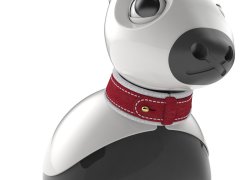What is MiRo?

MiRo is a series of robots targeted at both the research lab and the classroom (primary, secondary and higher) that aims to accelerate progress in social and companion robotics research and to foster public engagement with robots. MiRo-E is a significant evolution of the previous edition - more robust, higher spec, and easier to maintain and work with. Aside from its use in R&D and in education, MiRo also makes a great show-piece, demonstrating as it does the engaging nature of robots built on biological principles of morphology and behaviour.
MiRo wants to be a different sort of robot. It's a very simple premise: animals are a lot smarter than today's robots in many respects. Not only that, they are robust, adaptable and good at communicating their feelings—all features that we'd like to see in our robots. So, rather than working out how to develop smart robots from scratch, our approach is to build robots that think and operate very much like animals; from their senses through to their decision-making processes, all the way through to their bodies and their behaviours.
Developed to be emotionally engaging by an international team led by the award-winning designer Sebastian Conran, and experts in biomimetic and 'brain-based' robots, Professor Tony Prescott and Dr Ben Mitchinson from the University of Sheffield, the MiRo platform is intended to accelerate research on next generation animal-like robot companions and provide an accessible route into 'biomimetic' robotics for all levels in the classroom.
MiRo's control architecture is based on twenty years of high level research on animal brains and behaviour giving it the first truly brain-like control system. Hacking this "biomimetic core" would be one way to get started on the road to learning about biomimetic robotics. However, MiRo is also happy to be a straightforward and obedient robot platform, if the application requires it. Through Wi-Fi you can control MiRo remotely and/or stream data from its sensory systems and internal state, or you can install control software on-board to make MiRo entirely independent. MiRo exposes its interface as a ROS (Robot Operating System) node.
How can you use MiRo?
As a research tool
MiRo is particularly suited for developing companion robots—the future social robots that will share our personal spaces, interact with each other and provide emotional engagement and entertainment. However, as an accessible, rich, and affordable platform, MiRo also expects to find work in robotics research more broadly.
As an educational tool
Those same qualities recommend MiRo's use in the classroom. With six exteroceptive senses, multiple degrees of freedom, an innovative brain-inspired control system, and an accompanying simulator, MiRo is a great platform for education. Students can get started—even in their own time—with the simulator, and work together to deploy their developments on a physical robot.
As an ambassador
MiRo's built-in "biomimetic core", an implementation of a set of components from our work with brain-based robotics, generates life-like behaviour out of the box. Left to roam free, MiRo never fails to garner attention, and likes to play at front-of-house, drawing in the crowds and acting as a talking point for outreach or promotion.
Your MiRo
Ultimately, your MiRo will become whatever you want it to. So join the MiRo community and help develop the next generation of biomimetic autonomous companion robots.

